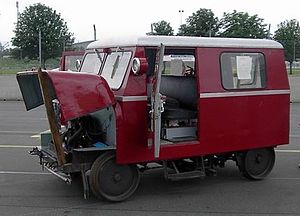DB class Klv 11 / Klv 12
| Klv 11 / Klv 12 | |
|---|---|
| Year of construction (s): | 1953-1962 |
| Axis formula : | A1 |
| Gauge : | 1435 mm ( standard gauge ) |
| Length: | 3300 mm |
| Height: | Klv 11: 1900 mm Klv 12: 1920 mm |
| Total wheelbase: | 2100 mm |
| Empty mass: | 1.5 t |
| Loading mass: | 750 kg |
| Top speed: | Klv 11: 70 km / h Klv 12: 60 km / h |
| Installed capacity: | 17.65 kW (24) |
| Motor type: | air-cooled petrol engine |
| Brake: | mechanically |
| Seats: | Klv 12: 6 |
The small car Klv 11 / Klv 12 is an auxiliary vehicle - railway maintenance office - draisine - for route travel purposes and maintenance work on railway systems (e.g. signaling and telecommunications systems). The Klv 12 have an operating weight of 1500 kg and a payload of 750 kg, with deviations from these values within the various series; the Klv 11 are generally about 200 kg heavier.
development
The first motorized trolleys procured in large numbers after the founding of the Deutsche Bundesbahn were the so-called Ämterdraisinen , officially known as BetriebsAmts-Draisine (BA-Draisine). It was intended exclusively for tours. The type designation can be found on the factory plates GBA (Gleiskraftwagen fürs BetriebsAmt). In the Klv series scheme introduced in 1956 ( Kl Einwagen mit V er internal combustion engine), these vehicles are referred to as Klv 11 and assigned to type 110.
The first delivery (pre-series for the BA and Bm draisines built later) was made in 1953. A total of 35 vehicles were procured from three manufacturers at the same time, of which only 5 remained according to the draisine catalog. Outwardly, the vehicles from FKF and Beilhack only differ in details, while the deliveries from Alpers look significantly different. The most noticeable visual differences:
- Draisinenbau Dr. Alpers Hamburg: small windows in the A-pillar
- FKF-Werke Fa. Schmitt (Frankfurt Motor Vehicle Factory): two rows of fans on the sides of the rear of the vehicle
- Beilhack GmbH, Rosenheim: a row of fans on the side of the rear of the vehicle
In the years 1953 to 1962 large numbers (696) of the Klv 12 (referred to as type D3 or also type 120) were ordered for railway maintenance companies (Bm), these were referred to as railway master draisines (Bm draisine). External features are two side doors and a rear door to the cargo area. The draisines were designated as Klv 12-4301 to Klv 12-4999.
Between 1958 and 1961, a total of 79 additional works office draisines, the KLV 11 (BA-Draisine, referred to as type GBA 2 or type 110) were ordered, which, however, differed greatly from the first delivery from 1953. An external feature are four side doors.
The German Federal Railways ordered another 30 Operating official Handcars that but with a year 1954/1955 VW bus - body were equipped, these were designated Klv 20 .
Manufacturer
The Klv were delivered in several lots from different manufacturers:
- Martin Beilhack Rosenheim, Draisinenbau Hamburg Dr. Alpers
- Frankfurt Car Body Factory Friedrich Schmitt (FKF)
- Industrial Works Karlsruhe (IWK)
- Sollinger Hut (SH).
Externally, the different series were essentially identical, at first glance they only differed in the different shapes of the bonnets.
drive
The Klv 11/12 are equipped with the air-cooled VW industrial engine with 28 HP, which is similar to the engine of the VW Beetle. The power is transmitted via a clutch and manual transmission from the automotive industry, there are four forward gears and one reverse gear. The maximum speed is 70 km / h, when reversing 16 km / h. The Klv 11 have an additional reversing gear so that the same speed can be achieved forwards and backwards.
Lifting and rotating device
The Klv 11/12 are equipped with a mechanical lifting and rotating device. It consists of a steel profile frame located in the middle under the vehicle, which can be lowered from the rear end of the vehicle using a hand crank and then supported on the rails. The vehicle is supported in the area of its center of gravity, so that one man is sufficient to turn it in the other direction of travel or to launch it at right angles to the track.
construction
The body was placed on a profile frame.
- Klv 11: There are four side doors, in the interior there are two seats and an emergency seat in the front and a bench in the back.
- Klv 12: There are two side doors and one rear door, there is a bench in the front and in the rear of the vehicle there are folding benches arranged lengthways.
commitment
The motorized trolleys were ideal for control and minor repair work (for example on signal systems, telecommunications equipment and level crossings).
With the Klv 12, a total of seven people (including the driver) could be transported or (including the weight of the driver) a total of 750 kg payload (material, tools) could be taken and brought directly to the construction site.
The last motorized trolley, the Klv 12, was retired from the DB in 1997.
Due to the robust construction and the simple structure, the Klv can be maintained with little effort, so that several dozen of them are still in use on museum railways today.
literature
- Oliver Strüber: The "great-grandchildren" of Mr. Drais . In: railway magazine . No. 8 , 2017, ISSN 0342-1902 , p. 48-51 .
Web links
- Ancillary vehicles website
- Klv 12-4990 at AG Märkische Kleinbahn
- Video: Driving and turning process on YouTube
- Klv 11-4111


